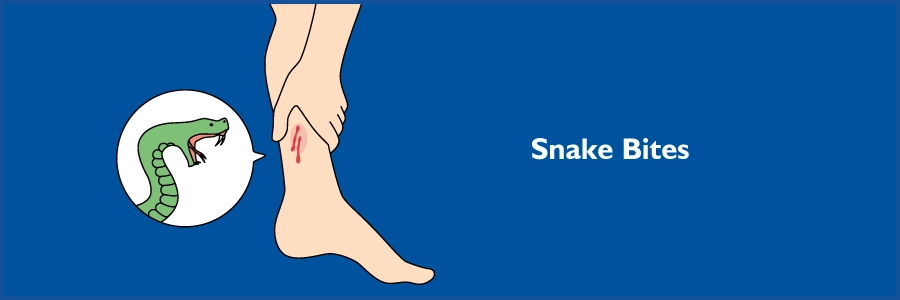
Empowering Yourself: Understanding and Responding to Snake Bites
Snake bites should never be ignored. While some bites are dry (non-venomous) and will induce swelling, while others are dangerous and can be fatal if not handled carefully and quickly.
Snakes bite to either catch their prey or defend themselves. As there are so many types of snakes, both poisonous and non-venomous, no two snake bites are the same. Different species have different forms of venom. Among the primary categories are:
- Cytotoxins: Swelling and tissue damage will occur at the bitten place
- Neurotoxins: Cause paralysis or other nervous system damage
- Anti-clotting agents: Stop the blood from clotting
- Myotoxins: Break down muscles
- Hemorrhaging: The blood vessels can be disrupted
Are snake bites dangerous?
There are two types of snake bites, one is more severe than the other:
Dry bites
These occur when a snake's bite does not produce any venom. These are usually observed with non-venomous snakes. But a dry bite can still be painful, along with bleeding, inflammation, swelling and/or erythema.
Venomous bites
These are significantly hazardous. They happen when a snake bites and injects venom. The symptoms of venomous snake bites are associated with excessive bleeding, severe pain, blood clotting issues, convulsions, blurred vision, etc.
Poisonous snakes voluntarily release venom when they bite, and they have the ability to control how much venom they can release. Envenoming or poisoning occurs in 50 to 70% of venomous snake bites. Even if the bite isn't life-threatening, the snake bite should be addressed as a medical emergency unless it is confirmed that the snake bite is non-venomous.Any delay in seeking medical attention after being bitten by a poisonous snake may cause serious harm, or in the worst case scenario, it may even be fatal!
Snakebite Symptoms
Symptoms of venomous snakebites
The following are possible signs or symptoms of a venomous snake bite:
- Pain at the bite site
- Nausea and Vomiting
- Numbness in the face and limbs
- Swelling and redness around the wounds
- Difficulty breathing
- Blurred vision
- Sweating and salivating
Symptoms of non-venomous snakebite
In the case of a non-venomous snakebite, the following symptoms may occur:
- Pain in the area
- Burning sensation
- Throbbing pain
- An arc of small puncture wounds can be visible
- Draining lymph nodes soon becomes painful
Secure your health with a second opinion. Make informed decisions and book your appointment today!
Get A Second OpinionPreventing Snake Bites
Some bites are almost impossible to avoid. These include a snake that attacks people when they step on it in the woods by accident. However, one can take precautions to lessen the risk of being bitten by a snake. These include:
- Keep an eye out for snakes swimming in the water to reach higher ground and those hiding under garbage, stones, fields or other things.
- If you notice a snake, slowly back away from it and do not touch it.
How are snake bites treated?
First and foremost, get medical attention right away. This means you should call emergency services as soon as possible because even if the bite isn't painful, you should still treat it as potentially life-threatening. Though it is extremely difficult, correctly recognizing the snake can help with treatment. Also, make sure you do the following steps right away:
- Wrap a clean, dry bandage around the bite.
- To reduce swelling and pain, apply a clean, cool compress or a wet dressing to the affected region.
- Keep an eye on the breathing and heart rate.
- In case of swelling, remove any rings, watches, and tight clothing.
- Make a note of the time the bite occurred so that it can be reported to an emergency room healthcare provider if necessary.
- To notify the emergency room specialists, remember what the snake looks like, its type, or its size.
One may be offered the following medications in the emergency department:
- Antibiotics used to prevent or cure the infection
- Pain medication
- Depending on the type of snake and the severity of the symptoms, a specific antivenom will be administered.
While these are all essential precautions, the most effective treatment for a snake bite is antivenom. Get the bite antivenom as soon as possible. Knowing the snake's size, color, and shape can help the doctor choose which antivenom is appropriate for the situation.
Do not do any of the following:
- Do not pick up the snake or attempt to catch it. Never touch a venomous snake, even if it is dead or decapitated.
- If you have been bitten, do not wait for symptoms to appear; get medical attention immediately.
- Do not take pain relievers.
- Do not apply a tourniquet.
- Do not apply ice to the wound or immerse it in water.
- Do not slash the wound with a knife or cut it in any way.
- Do not attempt to extract the poison.
- Do not use alcohol as a pain reliever.
- An electric shock or folk remedies should not be used.
Ready to take control of your health journey? Book your appointment now and start your path towards wellness today!
Book an Appointment
Categories
- Cardiology 84
- Dermatology 45
- Endocrinology 33
- ENT 16
- Fertility 190
- Gastroenterology 78
- General-Medicine 81
- General 6
- Gynecology 80
- Hematology 19
- Infectious-Diseases 33
- Neurology 52
- Oncology 34
- Ophthalmology 23
- Orthopedics 69
- Pediatrics 31
- Procedure 23
- Public-Health 144
- Pulmonology 59
- Radiology 8
- Urology 68
- Wellness 161
- Woman-and-child 77